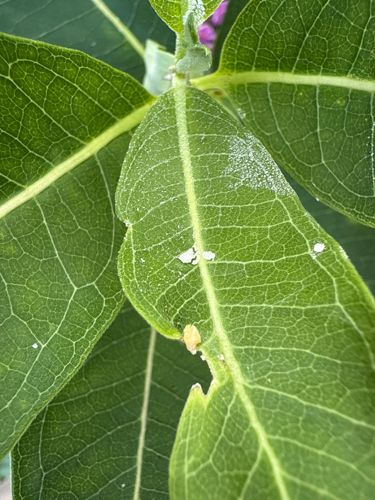Aphids (specifically, likely Milkweed Aphid or Oleander Aphid based on the host plant, though confirmation requires closer inspection)
Scientific Name: Aphis nerii (Oleander Aphid / Milkweed Aphid is a strong possibility given the apparent host plant)
Order & Family: Order: Hemiptera; Family: Aphididae
Size: Typically small, ranging from 1 to 4 millimeters (0.04 to 0.16 inches) in length.

Natural Habitat
Aphids are found worldwide in a wide variety of terrestrial habitats where their host plants grow. They commonly infest garden plants, agricultural crops, trees, and shrubs. The ones in the image are on the leaves of what appears to be a milkweed plant.
Diet & Feeding
Aphids are sap-feeders. They insert their needle-like mouthparts (stylets) into the phloem vessels of plants to extract sap. The image shows small yellow-orange insects on what appears to be milkweed, consistent with Aphis nerii, which specializes in feeding on milkweed and oleander plants.
Behavior Patterns
Aphids reproduce rapidly, often through parthenogenesis (asexual reproduction), meaning a single female can produce many offspring without mating. This leads to quick population growth. They are largely sessile once they find a suitable feeding spot, but winged forms can develop when colonies become overcrowded or food resources dwindle, allowing them to disperse to new host plants.
Risks & Benefits
Risks: As pests, aphids can cause significant damage to plants by stunting growth, distorting leaves, and transmitting plant viruses. Their feeding can lead to wilting and yellowing. They also excrete honeydew, a sticky, sugary substance that can attract sooty mold, further impeding photosynthesis. Benefits: While generally considered pests, aphids can be a food source for beneficial insects like ladybugs, lacewings, and hoverfly larvae, making them part of the local food web. They also play a role in introducing diversity into plant communities through their selective feeding.
Identified on: 8/15/2025